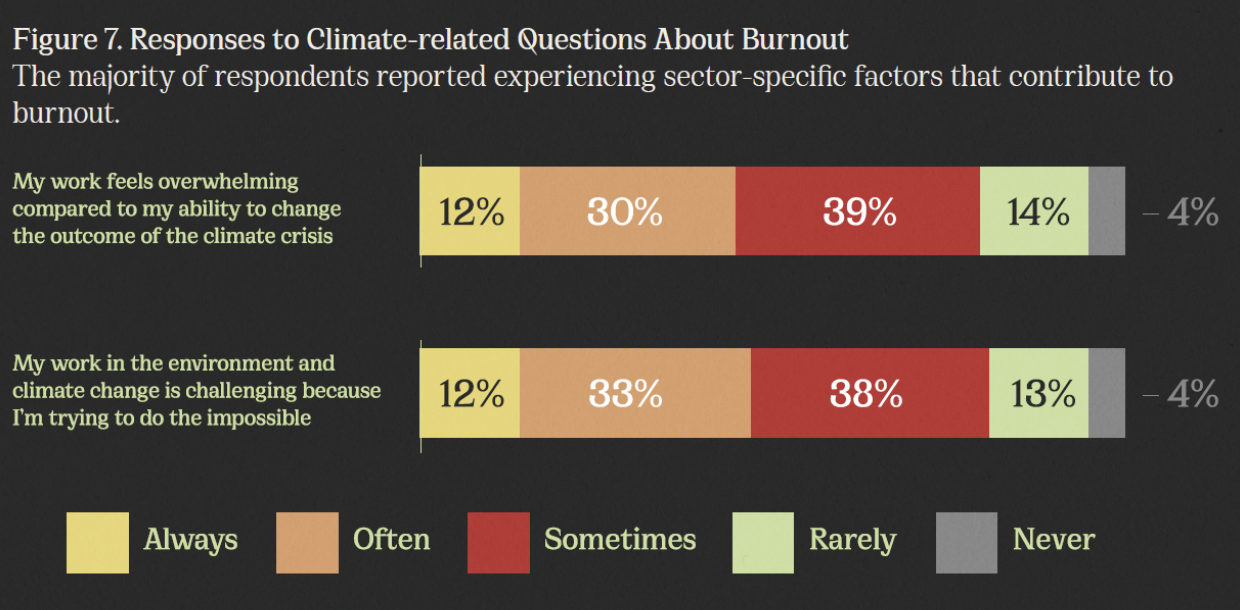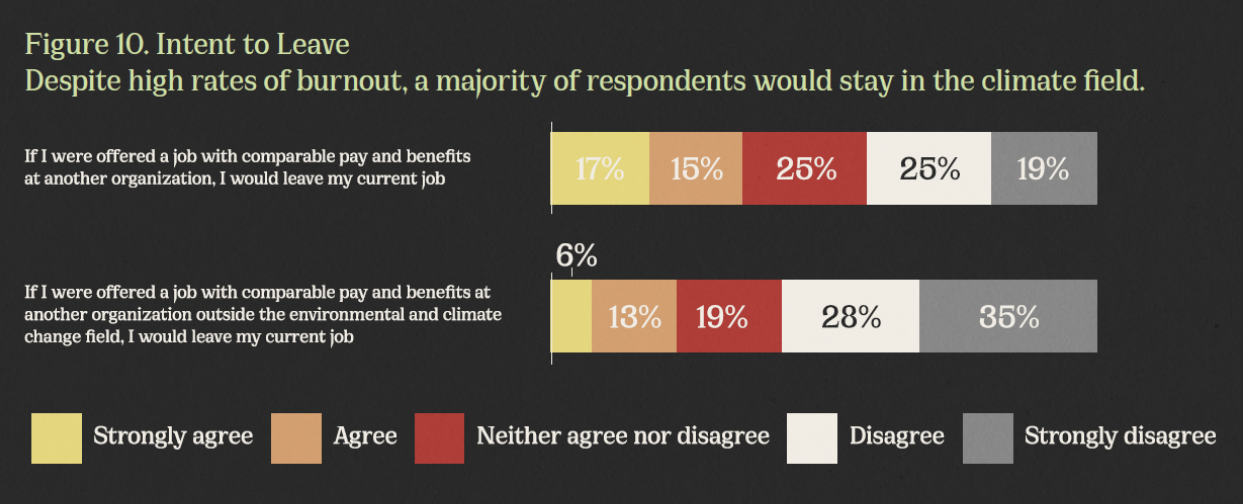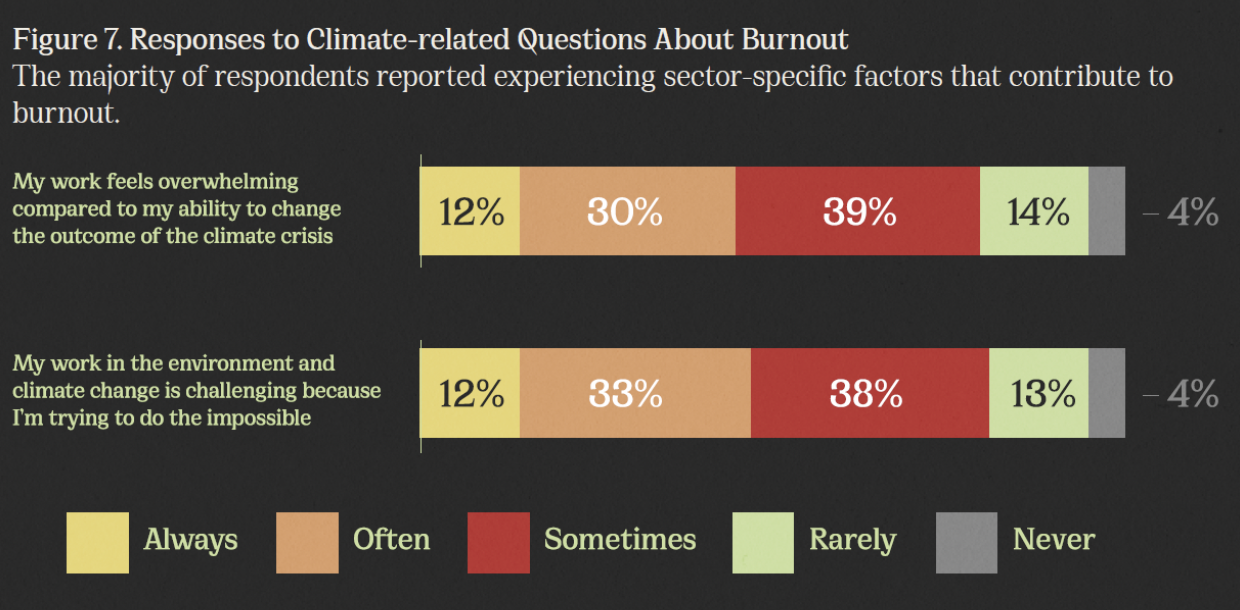Over 40 percent of workers globally report feeling burned out, and it only appears to be growing. Corporate pressure for more, faster, better is partially to blame, but so may be an internalized narrative that our value as humans lies in our output and external validation. This is true for so much of our workforce, but burnout has a different flavor and intensity for those working in climate and sustainability. Climate burnout is corporate burnout mixed with incredibly challenging emotions that come with the nature of the work, such as eco-anxiety, grief and even despair.
The World Health Organization defines burnout as “resulting from chronic workplace stress that has not been successfully managed” and is characterized by exhaustion, cynicism, mental distancing from one’s job, and reduced self-confidence. Burnout can happen in any job, but when you work in climate, the stress can be even harder to “manage” — you can’t just leave work at work.
Climate burnout is bad for everybody: Employees’ mental health suffers; employers suffer productivity loss and turnover of strong talent; and the rest of us lose out because we need people fighting to protect our planetary home. So before we get into possible solutions, what are the main causes of climate burnout?
Key causes of climate burnout
According to McKinsey, key causes of general burnout include toxic workplace behavior, lack of inclusivity, unsustainable workload, unsupportive growth environments, and stigma. Climate burnout may be a result of the above causes, plus some additional contributors specific to the nature of climate work.

![]()
![]()
![]()
![]()
![]()
![]()
![]()
![]()
![]()
![]()
![]()
![]()
![]()
![]()
![]()
![]()
1. The constant sense that we’re running out of time
The urgency pushed forward by the climate crisis is enough to send a climate worker on a spiral of “I’m not doing enough.” Everytime you see smoke outside your window from a wildfire or read news of another natural disaster made more severe and common by human activity, you are reminded that we are not acting urgently enough.
On top of that, climate work can sometimes feel detached from any positive impact. Academics may feel their findings are too distant from tangible solutions; activists can feel as though their actions are in vain when years of hard work are undone with one election or piece of legislation. Those working in corporate sustainability may worry that their hard work boils down to mere greenwashing. People join climate work to make a difference, and wondering if your work is futile can be exhausting.
2. Factions and frustrations
Within climate work there are factions and arguments that can hinder progress and hurt employee morale. Green growth or degrowth? Technological carbon capture or soil carbon capture? Mitigation or adaptation? Who pays for historic emissions? Noise and inner fighting can demoralize and frustrate even the most resilient of climate workers.
As stated in Climate Burnout Report, some respondents felt that their burnout stemmed from a feeling of impotence: “that they couldn’t ‘move the needle’ through their work, because of political roadblocks, funding restrictions, or because their work was incremental and reactionary rather than systemic and strategic. Participants noted feeling overwhelmed by climate change and stated that they felt their work was accomplishing little to combat the problem.” Seeing the tangible impact of one’s work is a helpful morale booster, and absent any evidence, it is easy to become demoralized.
3. Compassion fatigue
It is exhausting to care all the time. It can drain people mentally and emotionally to think about the climate crisis both at work and at home, when the bad news keeps coming (Biodiversity loss! Desertification! Climate disasters!). It has become increasingly difficult to disconnect and rest.
Possible solutions to climate burnout
Beyond the standard (but important!) solutions to burnout including fair/competitive pay and benefits, ample and meaningful time off and meaningfully implementing inclusive management practices, here are a few climate work-centered solutions to employee burnout.

![]()
![]()
![]()
![]()
![]()
![]()
![]()
![]()
![]()
![]()
![]()
![]()
![]()
![]()
![]()
![]()
1. Create and promote support networks
These can be groups of peers, mentors or identity/affinity-based groups that allow for communal grieving and sharing in the difficult climate change-induced emotions. Bringing the difficult emotions that come up from this work into the workplace is essential for people to continue to show up day after day and feel supported. Consider checking out Climate Workers Circles — weekly conversation circles from One Resilient Earth.
2. Adopt Employee Assistance Programs (EAPs)
Companies should consider adopting robust EAPs, which can include individual and group counseling and coaching, “stay interviews” and referral services at no cost to the employee. These services are an acknowledgement that employees are not always OK, and psychologically safe workplaces encourage workers to seek support — at no additional cost to the employee — when needed.
3. Formalize and incentivize ‘Green Time’
This can look like paid work days where colleagues spend time together in nature or volunteering for community organizations, connecting back to the why of their work — a communal love and protection of this beautiful planet.
4. Climate distress-aware manager training
Managers and corporate leadership should be trained to deal with the difficult climate emotions of their reports. Managers and leaders can start by educating themselves about empathetically addressing climate emotions for themselves and their employees using resources from Climate Psychology Alliance and All We Can Save.
5. Don’t only focus on doom and gloom
Much of climate work is seeing everything that is wrong with the state of the world (and there’s a lot!) but living in the problem space 24/7 is not sustainable. Bring in “good climate news” and normalize discussing progress, innovations, new policies and what’s actually working. Resources such as Environmental Defense Fund’s Good News page, The Daily Climate’s Good News page, or HappyEcoNews can be part of organizational rituals that boost morale and inspire new ways of thinking. In addition to global news, celebrate your organization’s wins, both big and small. Climate workers need to know something real and meaningful is coming from their hard work.
6. Break down silos
As mentioned above, many climate workers feel burned out because of factions and a perceived lack of their work turning into actionable impact. It’s leaders’ responsibility to encourage collaborations across sectors and rethink how things can be done. That means that important research has to leave universities. That means best practices and new technologies must be shared to foster innovation and widespread implementation. We need to find mechanisms and incentives to foster collaboration over competition in climate work.
We need climate workers to stay in climate work, and we need even more people to join. That means that we need to take wellbeing seriously, and as the Climate Burnout Report states well, “consider the emotional costs of doing work for everyone on earth.”
- SEO Powered Content & PR Distribution. Get Amplified Today.
- PlatoData.Network Vertical Generative Ai. Empower Yourself. Access Here.
- PlatoAiStream. Web3 Intelligence. Knowledge Amplified. Access Here.
- PlatoESG. Carbon, CleanTech, Energy, Environment, Solar, Waste Management. Access Here.
- PlatoHealth. Biotech and Clinical Trials Intelligence. Access Here.
- Source: https://www.greenbiz.com/article/6-ways-combat-burnout-your-climate-career
- :has
- :is
- :not
- :where
- $UP
- 15%
- 610
- a
- About
- above
- absent
- academics
- accomplishing
- across
- acting
- actions
- activists
- activity
- actually
- adaptation
- addition
- Additional
- addressing
- adopt
- Adopting
- After
- All
- allow
- always
- an
- and
- Another
- any
- ARE
- arguments
- AS
- Assistance
- At
- back
- Bad
- bar
- BE
- beautiful
- because
- become
- been
- before
- behavior
- benefits
- BEST
- best practices
- Better
- Big
- boost
- booster
- both
- Break
- bring
- Bringing
- burned
- but
- by
- CAN
- capture
- carbon
- carbon capture
- care
- Career
- causes
- celebrate
- Center
- challenging
- change
- characterized
- checking
- circles
- click
- Climate
- Climate change
- climate crisis
- coaching
- collaboration
- collaborations
- colleagues
- combat
- come
- coming
- Common
- communal
- community
- competition
- Connecting
- Consider
- constant
- continue
- contributors
- Conversation
- Corporate
- Cost
- Costs
- create
- crisis
- daily
- data
- day
- Days
- deal
- Defense
- despair
- difference
- different
- difficult
- disaster
- discussing
- Distant
- doing
- done
- Dont
- doom
- down
- drain
- earth
- easy
- EDF
- educating
- Election
- Emissions
- emotional
- emotions
- Employee
- employees
- employers
- encourage
- enough
- environments
- essential
- Ether (ETH)
- Even
- everybody
- everyone
- everything
- evidence
- external
- factions
- faster
- feel
- few
- fighting
- Find
- findings
- Focus
- For
- Forward
- Foster
- from
- funding
- futile
- General
- get
- Global
- Globally
- good
- graph
- Green
- Group
- Group’s
- Growing
- Growth
- happen
- Hard
- hard work
- harder
- Health
- helpful
- here
- hinder
- historic
- Home
- How
- HTTPS
- human
- Humans
- Hurt
- if
- Impact
- implementation
- implementing
- important
- impotence
- in
- Incentives
- incentivize
- include
- Including
- Inclusivity
- increasingly
- incredibly
- individual
- Innovation
- innovations
- inspire
- intent
- into
- IT
- Job
- join
- just
- Key
- Know
- Lack
- leaders
- Leadership
- Leave
- Legislation
- lies
- like
- little
- living
- Look
- look like
- lose
- loss
- love
- made
- Main
- make
- manage
- managed
- management
- manager
- Managers
- many
- May..
- McKinsey
- meaningful
- means
- mechanisms
- mental
- Mental health
- mentioned
- mere
- mitigation
- mixed
- more
- most
- move
- much
- must
- NARRATIVE
- Natural
- Nature
- Need
- needed
- New
- New technologies
- news
- no
- Noise
- noted
- of
- off
- on
- ONE
- only
- or
- organization
- organizational
- organizations
- our
- out
- output
- outside
- over
- overwhelmed
- paid
- part
- participants
- Pay
- pays
- peers
- People
- perceived
- piece
- planet
- plato
- Plato Data Intelligence
- PlatoData
- plus
- policies
- political
- positive
- possible
- practices
- presentation
- pressure
- Problem
- productivity
- Programs
- Progress
- promote
- protect
- protection
- Psychology
- pushed
- rather
- Read
- real
- reasons
- Reduced
- Referral
- report
- Reports
- research
- resilient
- Resources
- respondents
- responsibility
- REST
- restrictions
- result
- resulting
- roadblocks
- robust
- running
- safe
- Sectors
- see
- seeing
- Seek
- send
- sense
- seriously
- Services
- severe
- shared
- sharing
- should
- show
- showing
- small
- Smoke
- So
- soil
- Solutions
- some
- something
- Space
- specific
- spend
- standard
- start
- State
- stated
- States
- stay
- stemmed
- Strategic
- stress
- strong
- Successfully
- such
- Suffers
- support
- Supported
- Sustainability
- sustainable
- systemic
- Take
- Talent
- tangible
- technological
- Technologies
- than
- that
- The
- The State
- the world
- their
- themselves
- There.
- These
- they
- things
- Think
- Thinking
- this
- those
- though?
- Through
- time
- to
- together
- too
- top
- trained
- true
- Turning
- turnover
- Universities
- unsustainable
- urgency
- us
- using
- vain
- validation
- value
- Volunteering
- was
- ways
- we
- weekly
- WELL
- wellbeing
- What
- when
- which
- WHO
- why
- widespread
- window
- Wins
- with
- wondering
- Work
- worker
- workers
- Workforce
- working
- Workplace
- workplaces
- world
- World Health Organization
- worry
- Wrong
- years
- you
- Your
- zephyrnet











